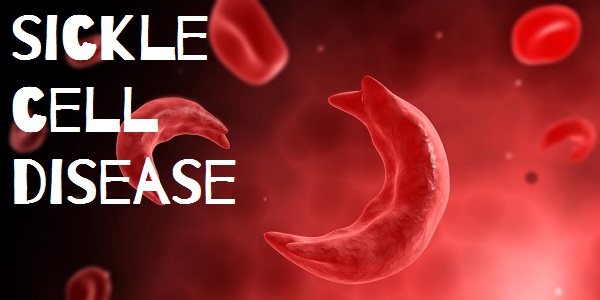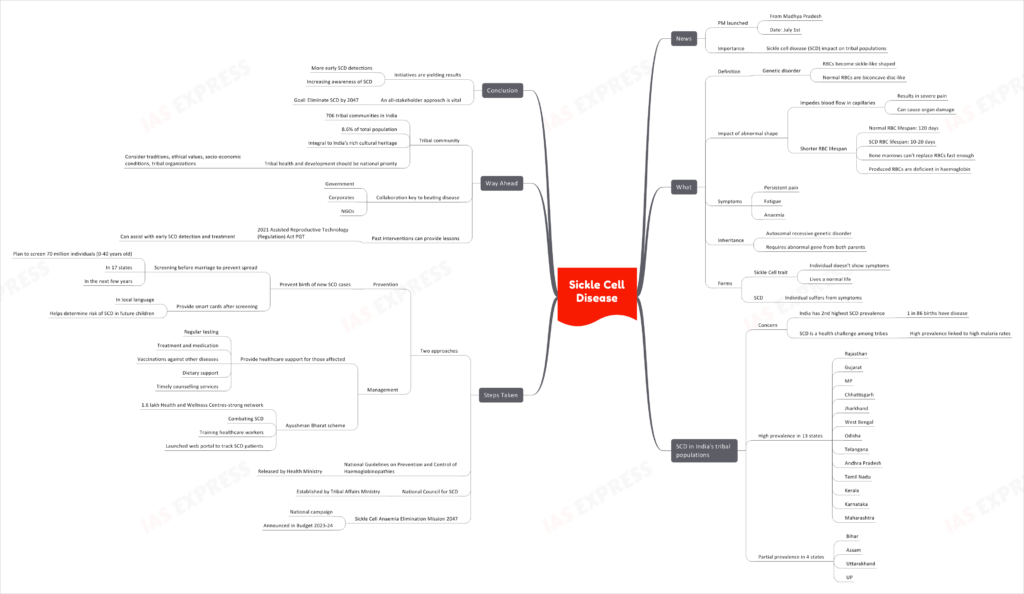Sickle Cell Disease- a Health Concern for India’s Tribes

On July 1st, the PM launched the Sickle Cell Anaemia Elimination Mission from Madhya Pradesh. In this light, there is a need to consider the issue of SCD and its disproportionate impact on tribal populations.

This topic of “Sickle Cell Disease- a Health Concern for India’s Tribes” is important from the perspective of the UPSC IAS Examination, which falls under General Studies Portion.
What is sickle cell disease?
- It is a genetic disorder in which the RBCs (red blood cells) become distorted into a sickle-like shape. Note that the normal RBCs are biconcave disc-like.
- This abnormal shape impedes the smooth flow of blood in the smaller capillaries. This leads to severe pain and even organ damage.
- While the lifespan of a normal RBC is 120 days, the RBCs of an SCD person last merely 10-20 days. The bone marrows aren’t capable of replacing them fast enough and what RBCs are produced are deficient in haemoglobin.
- The symptoms include:
- Persistent pain
- Fatigue
- Anaemia
- This autosomal recessive genetic disorder results when a person inherits the abnormal gene from both parents.
- The SCD exists in 2 forms:
- Sickle Cell trait: In this form, the individual doesn’t show the typical SCD symptoms and lives a normal life.
- SCD: In this form, the individual suffers from the SCD symptoms.
Why is it of concern for India’s tribal populations?
- India has the 2nd highest prevalence of SCD in the world with 1 in 86 births having the disease.
- It is a serious health challenge especially among the tribes. This vulnerability is linked to the high prevalence of malaria in their geographies. To overcome malaria-related deaths, sickle-shaped blood cells became an evolutionary trait.
- There is a high prevalence of SCD in 13 states:
- Rajasthan
- Gujarat
- MP
- Chhattisgarh
- Jharkhand
- West Bengal
- Odisha
- Telangana
- Andhra Pradesh
- Tamil Nadu
- Kerala
- Karnataka
- Maharashtra
- There is a partial prevalence in 4 states:
- Bihar
- Assam
- Uttarakhand
- UP
What has been done?
- Efforts to eliminate SCD are through 2 approaches:
- Prevention- i.e. preventing the birth of new cases
- When two individuals with Sickle Cell trait marry, their child has a high probability of having SCD. Hence screening of individuals before marriage can help curb the spread of SCD.
- The Ministry of Health, the Ministry of Tribal Affairs and the state governments have come up with a plan to screen 70 million individuals (0-40 years old) in 17 states within the next few years.
- After screening, smart cards would be provided to the individuals in their local language. This is to help them determine whether their future children are at the risk of acquiring SCD.
- Managing treatment and providing adequate healthcare support for those affected by SCD.
- For individuals who are identified as affected by the SCD:
- Regular testing will be done.
- Treatment and medication would be provided.
- Vaccinations would be given against other diseases.
- Dietary support would be given.
- Timely counselling services would be provided.
- Under the Ayushman Bharat scheme, the 1.6 lakh Health and Wellness Centres-strong network is playing a key role in combating SCD.
- Healthcare workers are being trained at these centres to provide better treatment for SCD patients.
- A web portal has been launched to track and maintain the records of SCD patients.
- For individuals who are identified as affected by the SCD:
- Prevention- i.e. preventing the birth of new cases
- The National Guidelines on Prevention and Control of Haemoglobinopathies was released by the Health Ministry.
- The National Council for SCD was established by the Tribal Affairs Ministry.
- Sickle Cell Anaemia Elimination Mission 2047- a national campaign was announced as part of Budget 2023-24.
What is the way ahead?
- India is home to 706 tribal communities, accounting for 8.6% of the total population. This tribal population is integral to India’s rich cultural heritage. As the PM noted, “the past, present, and future of India will never be complete without the indigenous communities.”
- Hence, the tribal community’s health and development should be a national priority. Efforts to ensure this must take into consideration their traditions, ethical values, socio-economic conditions and tribal organizations.
- Collaboration among the government, corporates and NGOs is key to beating this disease.
- Lessons from the past interventions can help too. For instance, according to the 2021 Assisted Reproductive Technology (Regulation) Act PGT (preimplantation genetic testing) can help with the early detection and treatment of SCD.
Conclusion:
The series of initiatives to tackle SCD is already yielding fruit, with more SCD cases being detected earlier and an increasing number of people becoming aware of this issue. Going forth, an all-stakeholder approach is vital for realizing the goal of eliminating SCD by 2047.
Practice Question for Mains:
Why is Sickle Cell Disease of special concern for India’s tribes? What is being done to eliminate the disease? (250 words)

